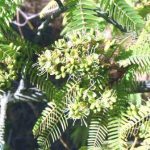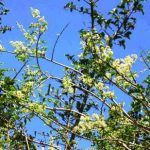TREE LIFE
FEBRUARY 1995
MASHONALAND CALENDAR
Tuesday 7th February. Botanic Garden Walk at 4.45 for 5 p.m. We will meet Tom in the public car park of the Gardens and continue with Rubiaceae.
Sunday 19th February. We have been to the Bromley area before but not to this particular farm – Liemba owned by Mr. Bill Carter. The usual selection of trees one would expect to find in this area are represented as are very good sedges and herbs which have appeared with the recent rains, so this will be a good opportunity to revise our tree knowledge and learn something about the ‘little stuff’. to meet at 9.30.
Saturday 25th February. Mark’s walk will be at Lyndhurst Farm which we visited recently and found to be very interesting. We propose to return to the vlei area to see what has come up after the recent rains.. We meet as usual at 3 p.m.
Tuesday 7th March. Botanic Garden Walk.
April 13th ¬– April 18th. Maundy Thursday to Independence Day. The Bulawayo Branch has reserved camping accommodation at Lion’s Den Enterprises Camp for the whole of this period and Harare members have been invited to join them. The camp is situated on the Bulawayo to Hwange Road at Dete. Tents or caravans and the daily tariff are $15 and $20 respectively. Mashonaland has been allocated 8 adult places and bookings can be made by phoning Ian or Margaret McCausland in Bulawayo. Details will be announced nearer the time.
Sunday 16th April. The third Sunday this month is in fact Easter Sunday, so there will be no outing. (See above).
May 25 to May 28 inclusive R I F A. We have been fortunate enough to reserve the RIFA Camp near Chirundu for a few days at the end of May 1995, for 20 members and 4 guests. Our guests are 2 hunters (obligatory for our safety), our caterer and Leslie Maasdorp who has a tremendous knowledge of the area and who has kindly agreed to accompany us.
The camp is not designed to accommodate a large number of people; therefore bookings will be on a strictly first come first booked basis.
The cost per person will be $325, which will cover three meals a day, accommodation in dormitories, and hopefully, excursions in 4 wheel drive vehicles within a limited radius of camp if required. Apart from personal belongings, the only other requirements are a mosquito net, sleeping bag, torch, insect repellent, malaria pills, sun barrier cream, and your own brand of tipple (it is unlikely that there will be fridge space for drinks, so if possible bring a cold box with ice).
We do stress that this is primarily a botanical trip although we won’t ignore a pride of lion at a kill should we bumble into one.
To book please phone Maureen Silva-Jones on 739711 during the day, or 740479 in the evenings.
MATABELELAND CALENDAR
Friday 3rd to Sunday 5th February. Buchwa – fully booked.
Sunday 5th March. To the Bickly family farm to look at Acacias and veld management.
BOTANIC GARDEN WALK: 3/1/95
Prior to the fourth session with Rubiaceae, Tom delved into a thicket of Ficus capreifolia to show us Zanthoxylum leprieurii, one of the Rutaceae family. In its understorey habitat the tree appeared more compact compared with the better-known Knob-wood Zanthoxylum chalybeum. A noticeable feature with the leaves was not only the pellucid glands, common to CITRUS, but the distinctive attenuate or “drip” tip. This species occurs mainly in low altitude forests and would be worth looking for in these areas, particularly in the Zambezi Valley.
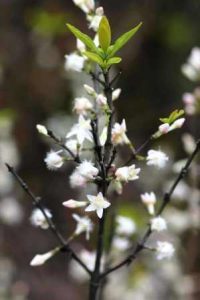
Tricalysia junodii var. kirkii, Photo: Bart Wursten. Source: Flora of Zimbabwe
In the medium and low altitude forest section we saw Tricalysia junodii var. kirkii, previously known as Tricalysia allenii, with broad loaves being slightly hairy and having a quilted surface. The fruits occur in bunches and when mature are noticeable by the persistent calyxes. Tricalysia jasminiflora, also an evergreen forest resident is a multi-stemmed shrub with the leaves on this plant having wavy margins.
In the understorey the distinctive tightly fissured pale bark of Tricalysia acocantheroides was examined, as were the VERY shiny leaves with pronounced drip tip. Tom mentioned that researchers had found hairless or glabrous leaves, shiny surfaces and the effect of a “drip tip” ensured that a leaf surface does not retain a film of water for long. This film, if not cleared, reflects sunlight and slows the vital process of photosynthesis.
Canthium inerme is a scrambling species where the specific name refers to the plant being unarmed, with only stubby branchlets on which new shoots were seen to be sprouting. Young branches have & pale grey colour and the mature bark is fissured with numbers of brown dots – possibly lenticels on the upper surfaces. Canthium pauciflorum, the other, was well protected by pairs of short curved spines occurring where branching takes place.
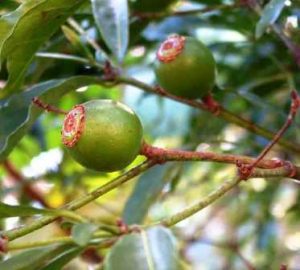
Rothmannia manganjae. Photo: Rob Burrett. Source: Flora of Zimbabwe
A feature of Rothmannia manganjae site is the group of three shiny leaves that are found at each branching point on the stems. This species also has leaves adapted for forest and understorey habitats. Another understorey species we saw was Rytigynia macrura, a deciduous shrub with small very pale green leaves, indented with dark green veins.
Pavetta incana grows in an area stretching from the Chirinda Forest to the Save River valley. Fortunately the flowers were still intact, with four white petals and a long delicate style, clustered in the leaf axils.
Pavetta umtalensis, differed from the previous by having larger shiny leaves with the bacterial nodules or “black dots”, typical of the Pavetta group being easily seen.
Thank you Tom for once again for taking us around and we look forward to our next Botanic walk.
-A. Macaughtan
LEOPARD ROCK NATURE RESERVE 2nd January
City Hall is really to be commended for its decisions to set aside certain tracts of land .in the Western Suburbs and to preserve these as Nature Parks. Such a one is the Leopard Rock Nature Reserve where on Monday 2nd January 1993 several members of the Bulawayo Branch visited.
We were struck immediately with the depredations wrought by the Great Frost of June and July. Really large Kirkia acuminata trees displayed dead naked branches on their tops. Various isolated pools in otherwise dry water courses indicated recent rainfall and the Kirkia had already started to coppice on their lower branches.
The place was fresh and green with new growth, but closer examination revealed much dead frosted material. We set off alone a path which presumably led down to the Khami River. The dam into which it flows glinted blue as we drove past it earlier, but it is in fact polluted by effluent.
I was pleased to be introduced to a new Euphorbia – Euphorbia espinosa. Vast granite kopjies dominated the undulating terrain and the trees were very much larger and thicker then any other genera.
Charles opined wisely that this was because the local tribes held these trees in awe as part of their spirit culture and did not cut or damage them, allowing them to outstrip their less fortunate neighbours.
After an hour or two of thirst forced some of us to return to the cars in search of rehydration. Having satisfied this need we set off down a different path. This wandered along the bank of a dry watercourse, but there was evidence in the form of drifted grass and twigs that rain had recently flowed down there. The area was very thickly wooded.
We came across a nganga, resplendent in dreadlocks and skirt, gathering roots and I was frightened half to heart failure? But he proved convivial and after greetings were exchanged we followed our separate ways.
Shortly I was to wilt and settled to rest on a convenient dry comfortable rock in the shade. The rest of the party continued down the slope to seek the river. As I sat there in the forest I was entertained by the Red-chested Cuckoo, who shouted “Piet my vrou” all around, but as is her wont, never actually revealed herself. Then I decided to count how many different trees there were that I knew. In the small area in my vicinity there were 18 plus another dozen that I didn’t know. A little earlier we had passed a granite slab with a large decorative Ficus ingens that I thought would look very well in my garden. Eventually after about an hour, I returned up the path to the cars. The others were somewhat tardy returning and a search party was dispatched and returned successfully.
Whilst we partook of lunch we marvelled at friendly moths that seemed attracted to us humans. These beautiful creatures, with iridescent blue and red stripes, were Arniocera erythopyga, Fire-grid burnets. The Burnet moths belong to a most intriguing and interesting family. They resist the poison of cyanide killing bottles and at least a few species contain cyanide themselves in their bodies. The bright colours advertise this to predatory birds which, if not actually dying as a result of eating them, will certainly suffer very bad indigestion!
The Leopard Rock Nature Reserve is well worth another visit. A splendid total of 86 trees and shrubs were noted, together with some smaller botanical specimens. The list is as follows: –
Acacia galpinii, Acacia karroo, Acacia nilotica, Acacia rehmanniana, Albizia amara, Albizia tanganyicensis, Aloe excelsa, Azanza garckeana, Bolusanthus speciosus, Burkea africana, Bridelia mollis, Canthium lactescens, Cassia abbreviata subsp. Clerodendrum glabrum, Clerodendrum myricoides, Combretum apiculatum, Combretum collinum subsp. Combretum erythrophyllum, Combretum hereroense, Combretum molle, Combretum zeyheri, Commiphora glandulosa. Commiphora mossambicensis, Croton gratissimus var. Dalbergia melanoxylon, Dichrostachys cinerea subsp. Diplorhynchus condylocarpon, Ehretia rigida, Elephantorrhiza goetzei subsp. Elephantorrhiza elephantina, Erythrina latissima, Euclea crispa subsp. Euclea divinorum, Euclea natalensis subsp. Euphorbia matabelensis, Euphorbia espinosa, Ficus abutilifolia, Ficus glumosa, Ficus ingens, Ficus tettensis, Ficus thonningii, Flacourtia indica, Flueggea virosa, Gardenia resiniflua, Gardenia ternifolia, Gardenia volkensii. Grewia bicolor, Grewia flavescens var. Grewia monticola, Heteropyxis dehniae, Kirkia acuminata, Lannea discolor, Lannea schweinfurthii, Markhamia zanzibarica, Maytenus senegalensis, Mundulea sericea, Ochna glauca and Ochna holstii, Ozoroa insignis. Pappea capensis, Pavetta gardeniifolia var. Peltophorum africanum, Pseudolachnostylis maprouneifolia var. Pterocarpus rotundifolius subsp. Rhus leptodictya, Rhus lancea, Salix subserrata, Sclerocarya birrea, Strychnos madagascariensis, Strychnos spinosa, Terminalia brachystemma, Terminalia sericea, Turraea obtusifolia, Vangueria infausta, Vitex payos, Ximenia caffra var. Ziziphus mucronata subsp. Barleria albostellata, Cissus cornifolia, Euphorbia griseola, Maytenus heterophylla subsp. puberula, Sarcostemma viminale, Tetradenia brevispicata, Tinospora caffra, Helinus mystacinus, Ornithogalum sp. Hibiscus mutatus, Ruspolia hypocrateriformis, and a Jasmine. I only saw two exotics, Jacaranda and a Lantana camara.
-Norma Hughes
FLORA’S HERBAL REMEDIES
RESURRECTION PLANT – Myrothamnus flabellifolius
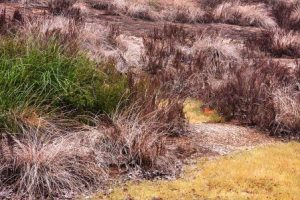
Myrothamnus flabellifolius. Photo: Bart Wursten. Source: Flora of Zimbabwe
A plant that favours the rocky granite outcrops where its long fibrous roots penetrate the cracks and seem to find sustenance. For most of the year it remains dry and brittle, but soon revives with the first rainfalls or if plucked and put into water – a most fascinating phenomena.
This plant has important medical uses and was frequently used by the early settler’s to this country.
A tea of 1 thumb-length sprig of green leaves to 1 cup of boiling water has a delightful fragrance and a subtle flavour and is a tonic, as well as easing cold and flu symptoms, kidney ailments, haemorrhoids, aches and pains.
A much stronger brew makes an excellent wash for grazes and wounds and a pad soaked in this brew and applied will ease backaches, strains and sprains.
Smoke from burning the stems and root is fragrant and soothes chest pains and congestion. Leaves can be smoked instead of tobacco or mixed with it for the same relief. Chewed green leaves freshen the mouth and relieve toothache. The fresh green leaves can be mixed with hand cream and rubbed or massaged into aching joints and muscles.
A stock of the dried plant can be kept and “resurrected” when needed. Truly an amazing plant.
WILD CAMPHOR – Tarchonanthus camphoratus
This is another shrub or small tree we often come across on our hikes and is very widespread in our country. The leaves and wood have a distinct camphor smell and are used as an insect repellent if placed between clothing, blankets or even food.
The seed heads when burned also give off a camphor smell and are used to fumigate huts. The smoke is inhaled to relieve rheumatism, congestion, headaches and sleeplessness.
Tea made from crushed leaves is taken for stomach ailments, asthma, over-anxiety and heartburn. The smoked leaves have a slightly narcotic effect.
Chewed leaves relieve chest ailments and sore throats. A strong brew of the leaves, used in the bath, also brings relief. An ointment can be made for chilblains and sore feet. Vaseline is used in making this ointment, the leaves being macerated in it.
The woolly seeds are used to stuff pillows which are said to relieve headaches and ensure a good night’s sleep; certainly a pleasant, fragrant one – would probably keep the mosquitoes away.
The wood is fragrant fine grained and polishes to a beautiful sheen and is used for making musical instruments and carvings and grain storage con¬tainers. The leaves and flowers are a pleasing addition to potpourri.
The tree is attractive if trimmed and shaped and an excellent and useful garden subject. The fragrant dried twigs can be used in the fire on a cold winter’s night. Lovely!
NYARUPINDA CATCHMENT December 1994
The Scene
The water level in the dam has gone down rapidly because more than a million gallons a day has been used for irrigation of bananas, groundnuts and tobacco.
The weather in a district is part of its Natural History; here are some early summer happenings and the emotions they evoked. Happiness when 130 mm rain fell in October. Suspicion that it was a false start in the wet season. Frustration as more than five weeks passed without any rain, maize withered away, other plants wilted and scorched, leaves of Wild Rubber tree, Velvet-leaved Combretum and snowberry drooped, high temperature exhausted humans and animals.
The storm which ended the drought was fearful; at Tinto despite the over-hanging thatched roof, hail threatened to break the window panes, curtains were closed to confine the glass should this happen, luckily windows withstood the onslaught. Hail-damaged tobacco was a humiliating sight; most of the leaves were on the ground. Wherever there was tress, green leaves littered the ground; in the garden tomatoes were pitted and vegetables scattered. Compassion was felt for two Kurrichane Thrush nestlings whose heads still trembled while the hailstorm moved on.
We marvelled when sunshine made the edges of a grey snake’s scales shimmer with spectrum colours and later when this same snake became Purple-glossed in water where it was confined for a photograph. Finally its release was remarkable for the ease and speed with which it burrowed into decaying leaves piled up against the fence.
Today 13 December, the circular water-storage tank was the habitat for some first sightings: a pair of Painted Reed frogs swam in tandem; beside a frothy nest there was a speckled matt grey tree frog, easily distinguishable from the shiny slippery grey species. Another tree frog identified itself with a mango tree branch close to the water. At dusk it was in the same place, its white throat was distended, it made a few gentle croaks, a Sunbird flew out of its nest on the other side of the mango tree… then it was dark and time for supper. It is nearly 10 p.m., there’s another summer sound which comes from vleis and occurs intermittently at night until shortly after sunrise. This sound is coming and going now, a repeated ascending hum sometimes in unison and often in sequence; it could be described as a melodious croak. It would be good to know what makes this noise, and to see its scientific name in Tree Life in 1995. This paragraph was Curiosity, is it an emotion?
Surprise, the female Zanha africana has produced a small crop of Wild apricots on the leeward side of the tree. See Tree Life, No. 177, since writing these observations there have been more flushes of male flowers.
Saline Solution Eye Remedy
Thank you Thora for the recipe for saline solution.
It is not a far cry from remedies to dyes, my attempt to make a blue dye from the crushed leaves of Terminalia sericea soaked in water, was not successful, the result was a pleasant-smelling khaki-coloured solution, Terminalia blue sounds good, what vital ingredient was missing?
Civet News
Several civetries have been observed since winter 1992. Only one civet has been seen since then, it was not caught in the act depositing dung but ran across the road near the river a kilometre from here. Recently, two more middens have been found, one in the old maize land at the end of the drive, the other in a disused hole beside a track near the dam, four hundred metres from this house. These sites make up for two abandoned civetries on the adjoining farm Chepstow, so there are still four places to watch. The site by the dam was last used when Monkey Plums (Diospyros lycioides) were eaten, say, in June or July. Very recently, as a result of the rain bringing out the Millipedes, there was defecation of their very foul smelling remains. This also has occurred at the site nearest the house. When the local Africans were eating fruits of Snot Apple (Azanza) and discarding dry fibrous portions, the same fruit passed through the civet after minimum mastication and digestion, in the form of an odourless glistening gelatinous mass. At this time the civet seemed unable to make up its mind which was number one heap for its number two, several places were used in the vicinity of the first midden, one of these efforts consisted of 27 Sand apple Seeds (Parinari sp.).
Apropos Parinari
In Rivers of Gold by Henrik Ellert, this tree is called Curatellifolia parinari, is this a name change or a printer’s error?
Frost Part 4
Making contact with people “in the know” concerning Trees and Frost is taking longer than expected; this means that Part 4 will be delayed. If you own or can borrow a copy of The Natural History of Selborne by Gilbert White, he has much of interest to say about the weather in temperate climes, his observations concerning trees and frost can be found in Letters LXI to the end i.e. Letter LXVI. These letters provide fascinating December and Christmas reading, relevant to this series on Frost. Icy spiculae, tentatively suggested by Gil White.
HOW INTERESTING that Eucalyptus camaldulensis was first described and named in Camalduli in Italy.
CHEERS, here’s hoping that 1995 will be better.
Benedicta Graves
ANDY MACNAUGHTAN CHAIRMAN


